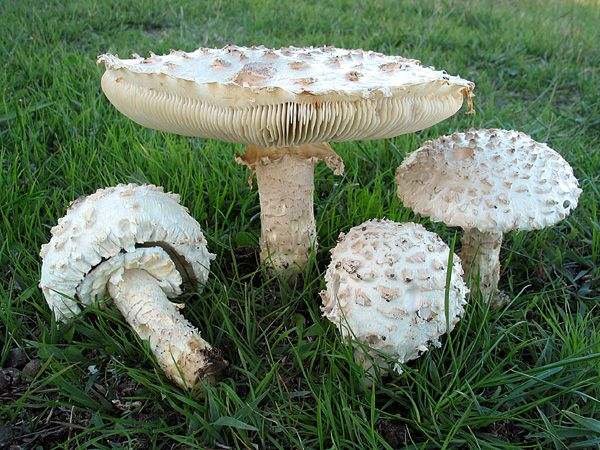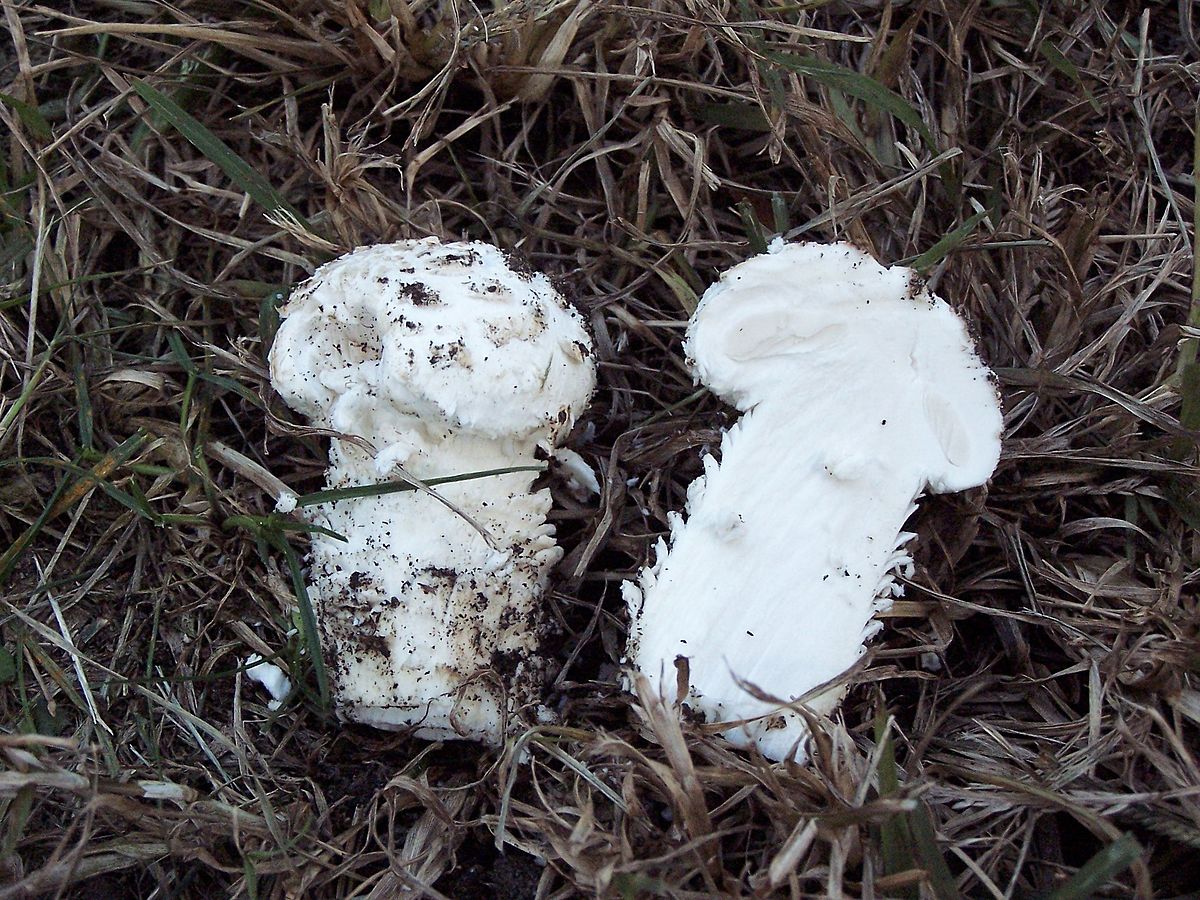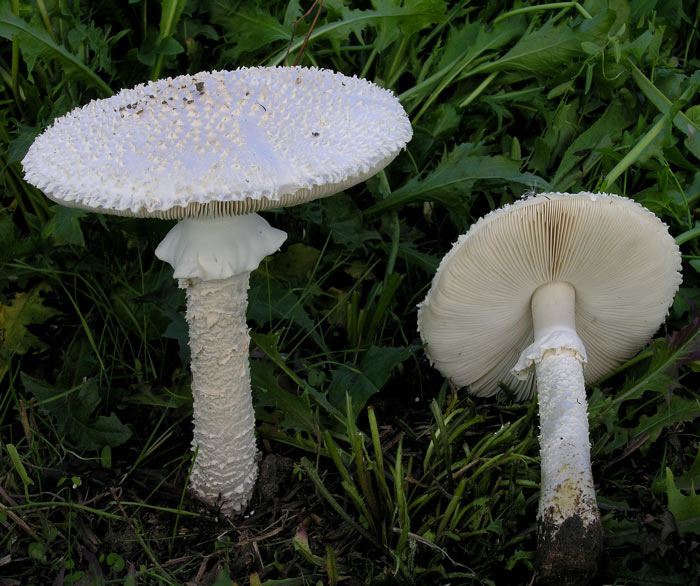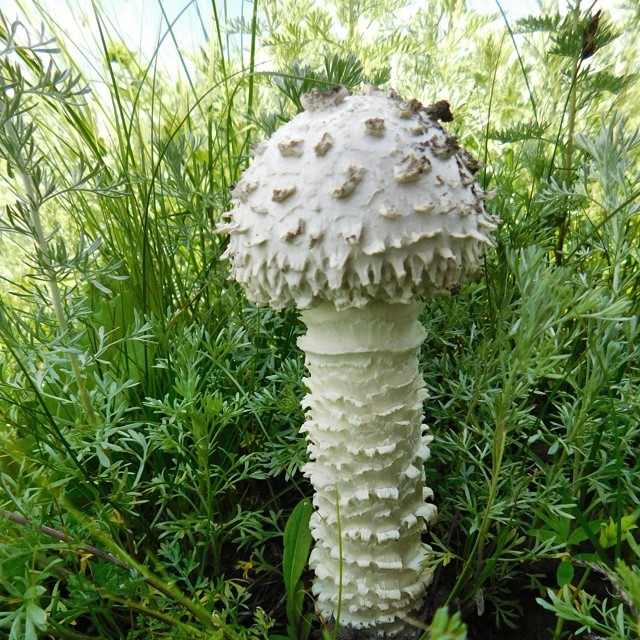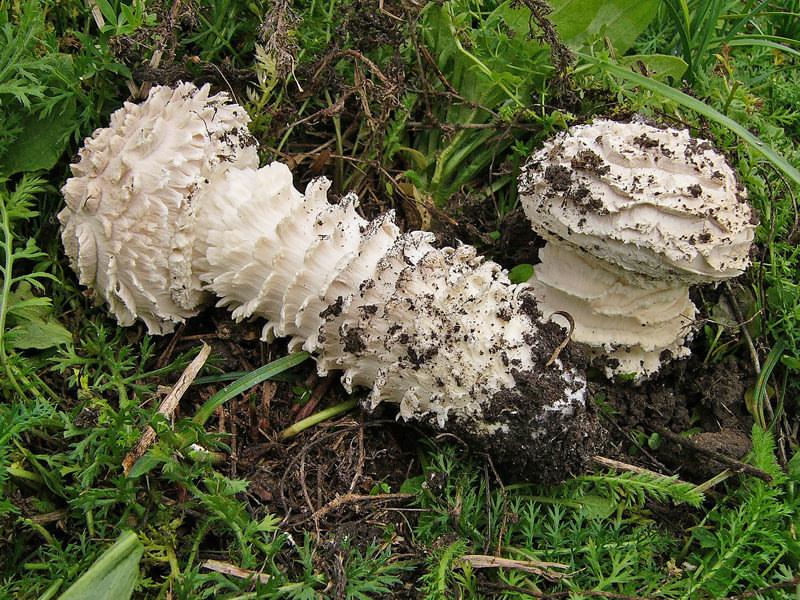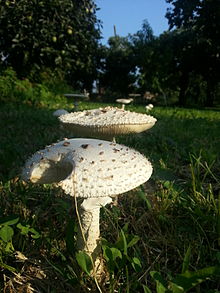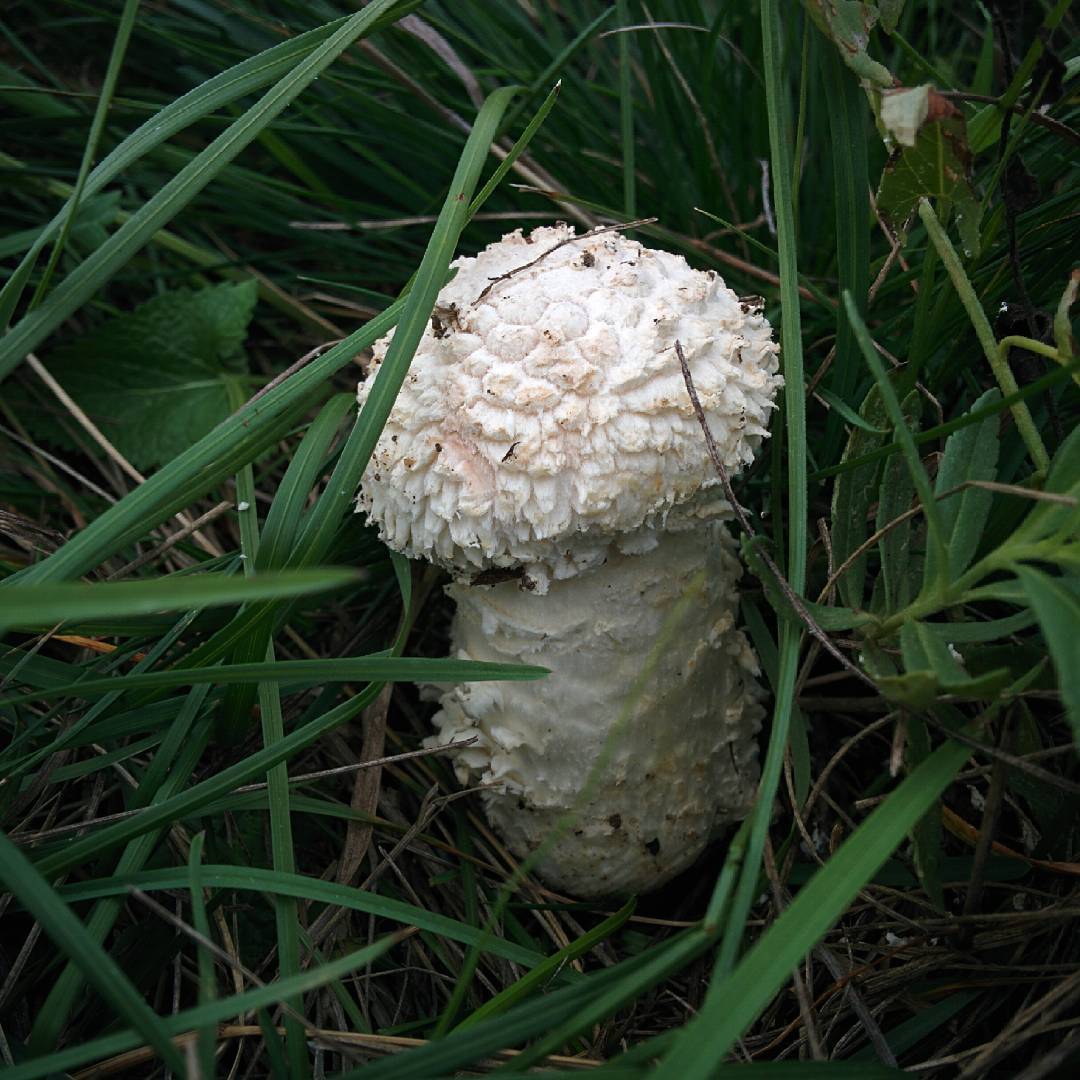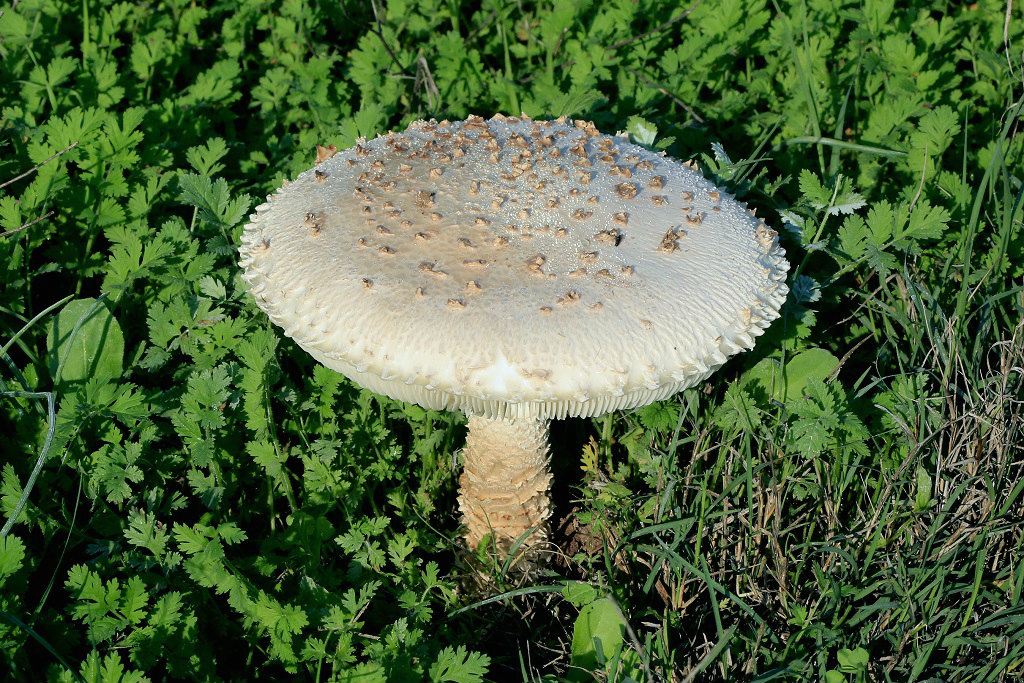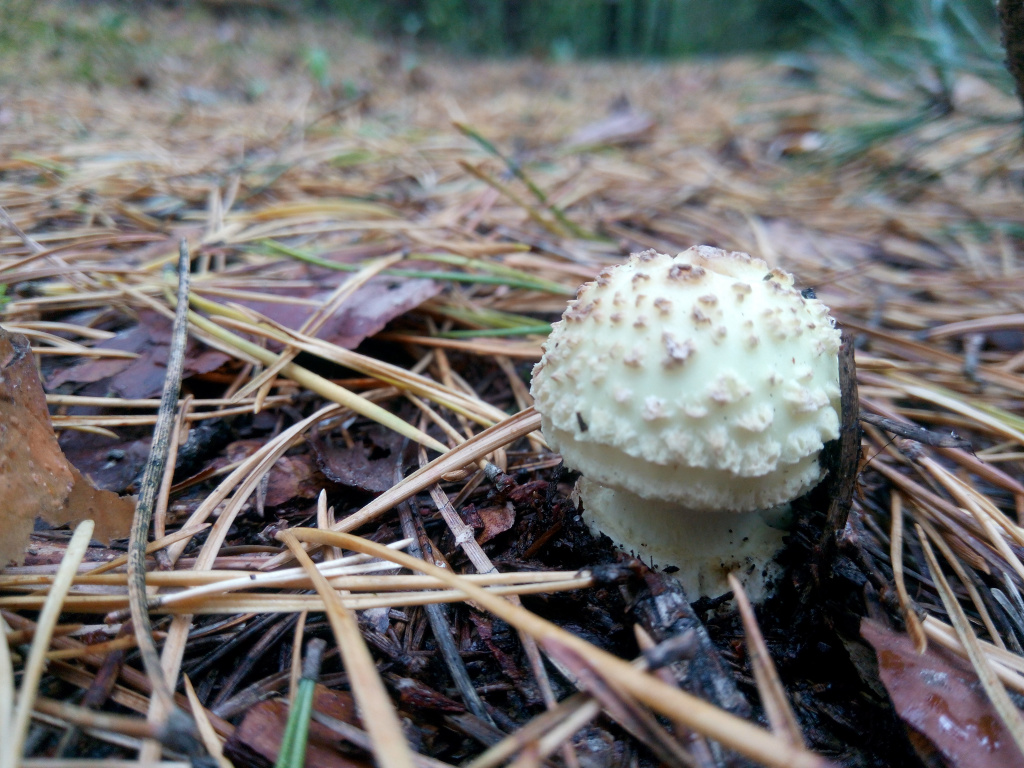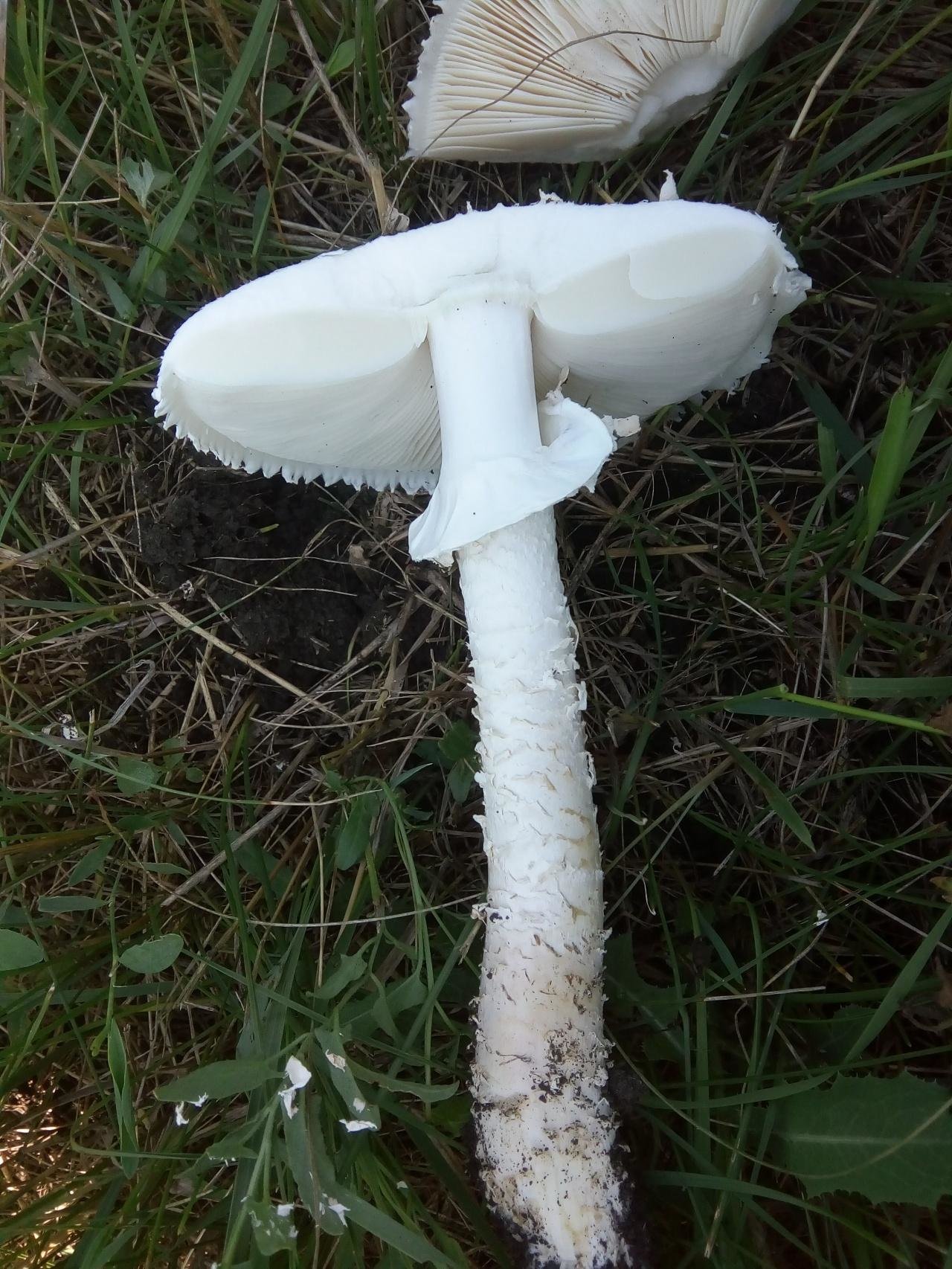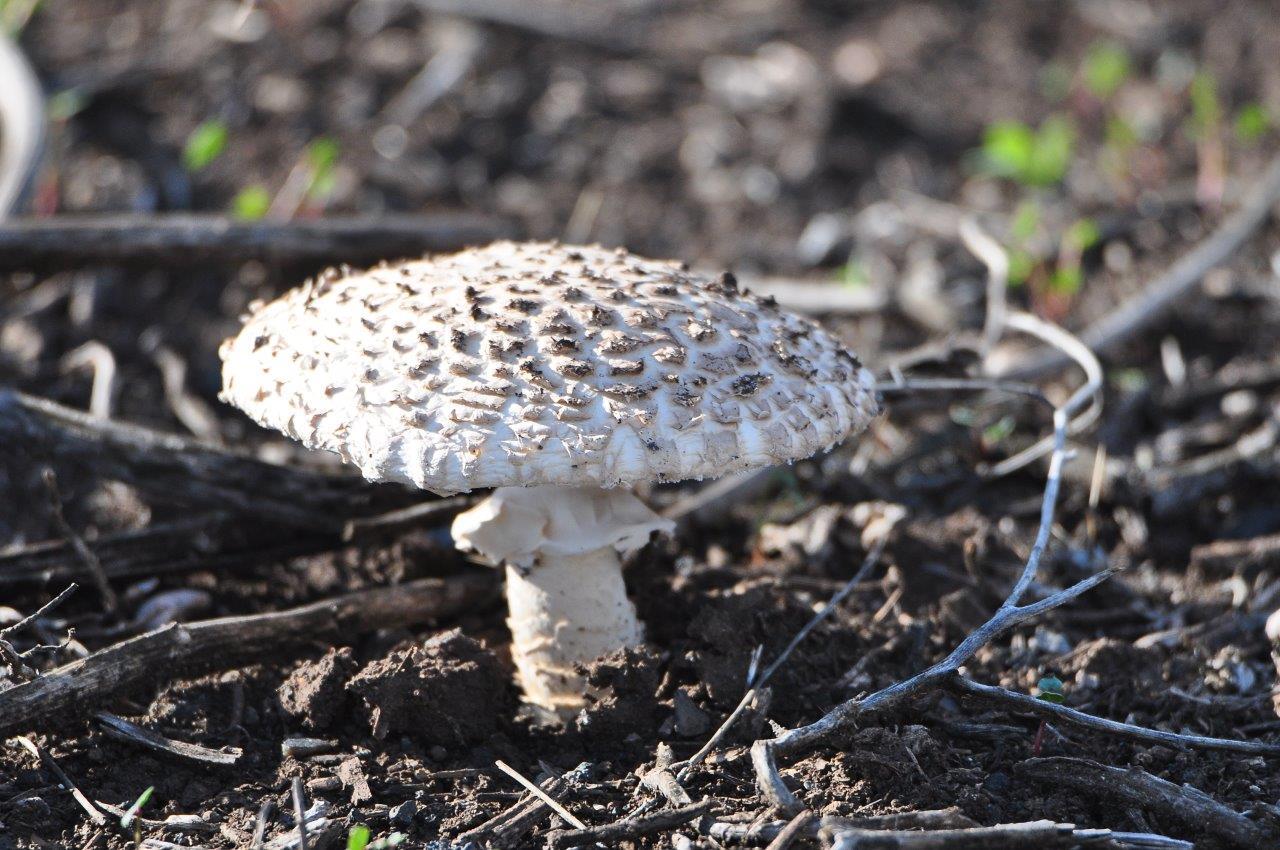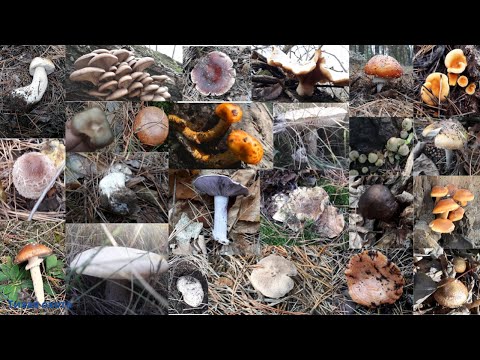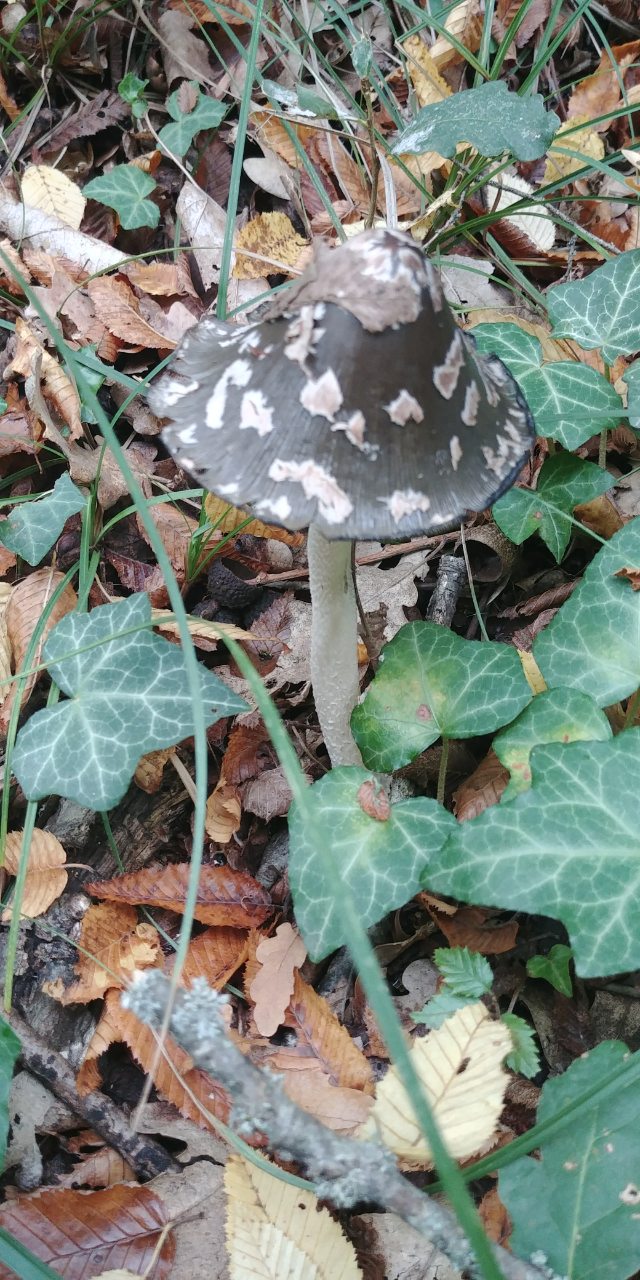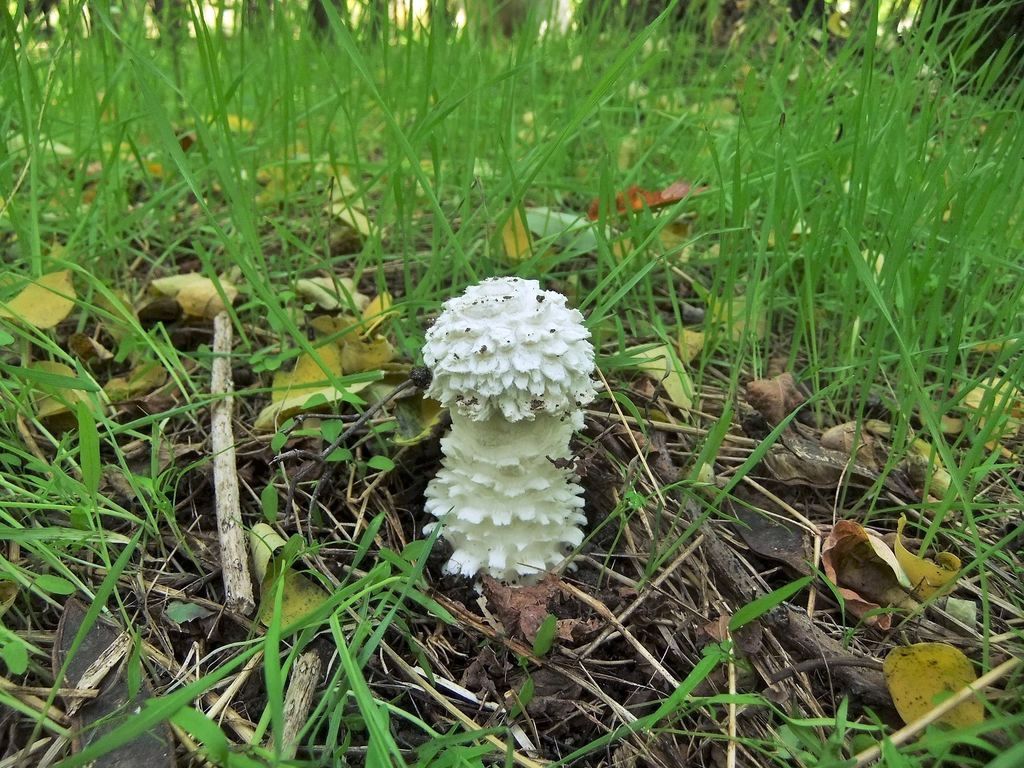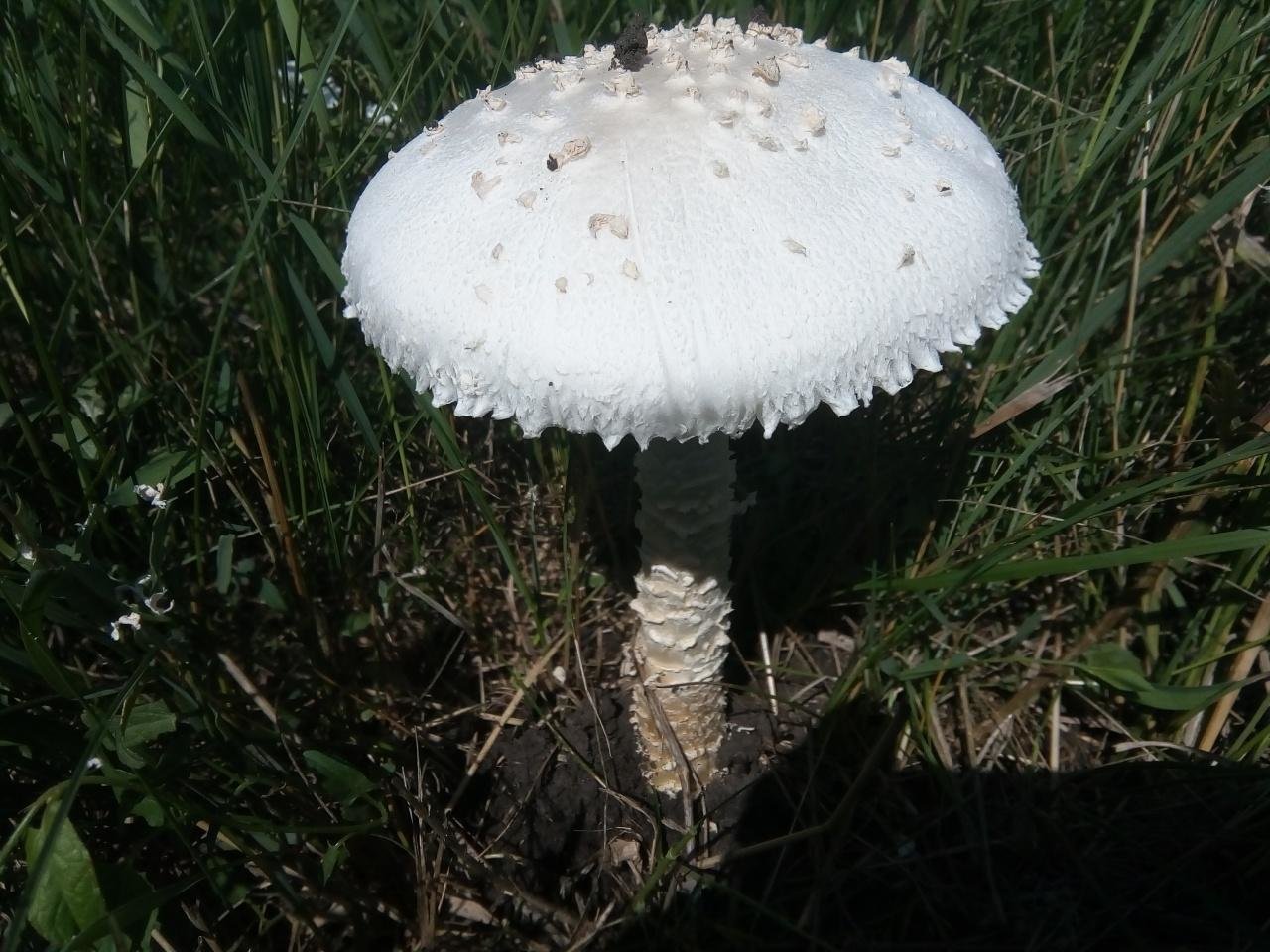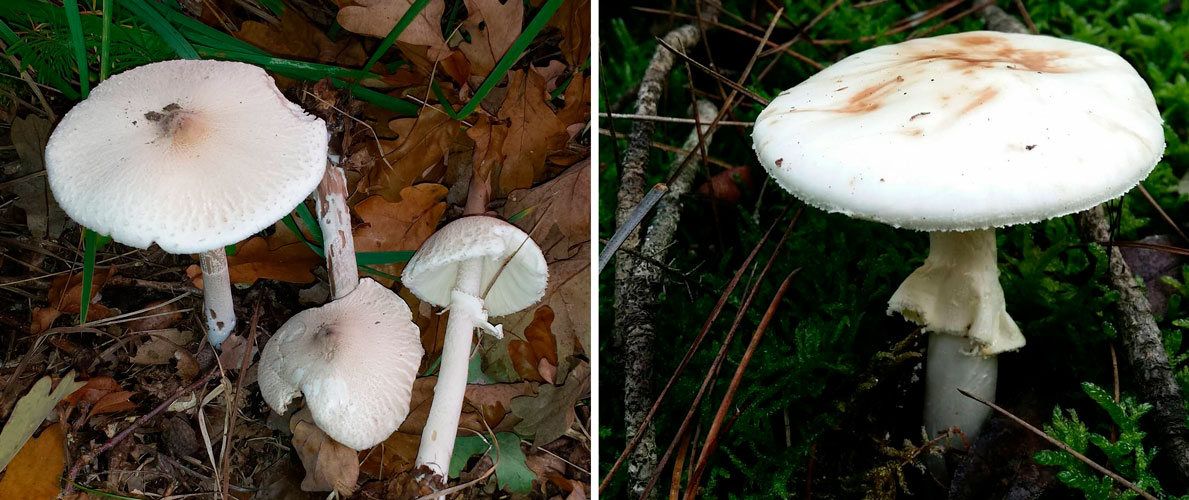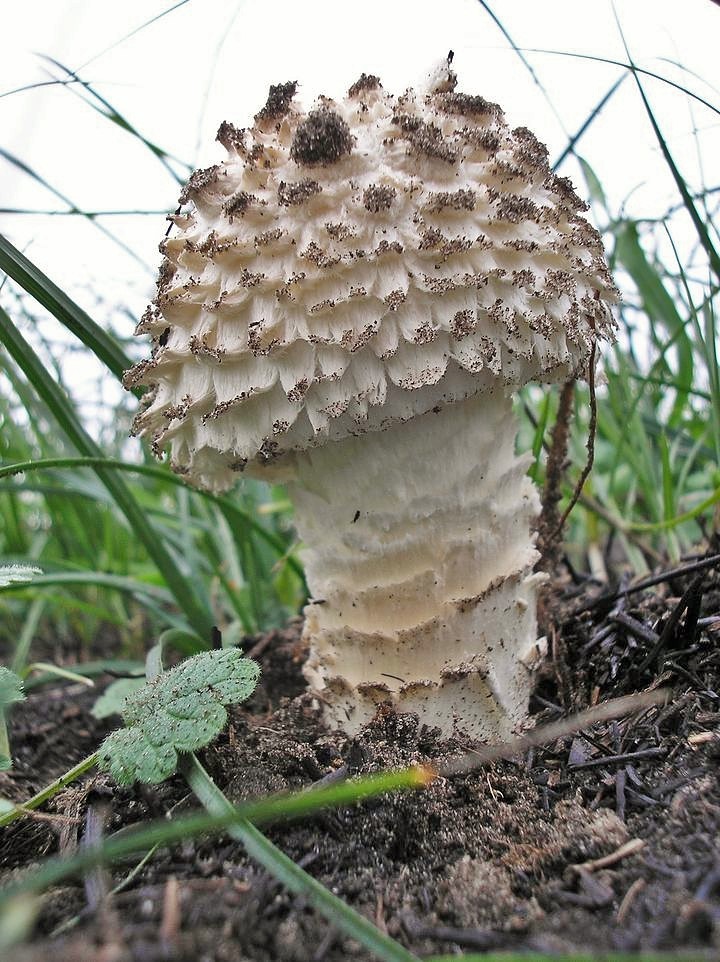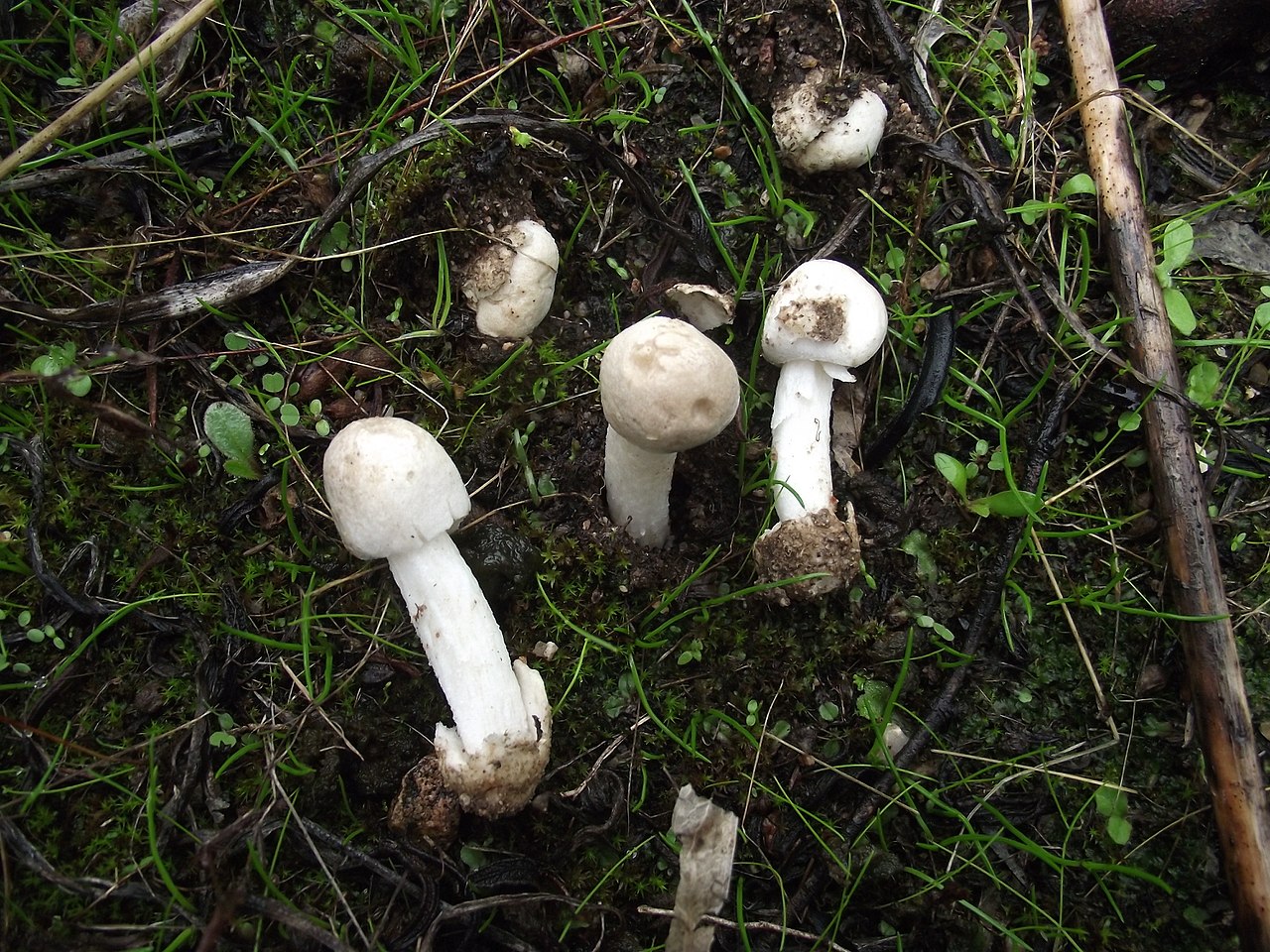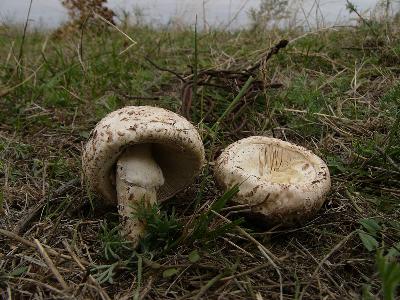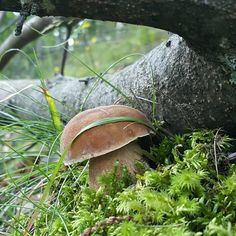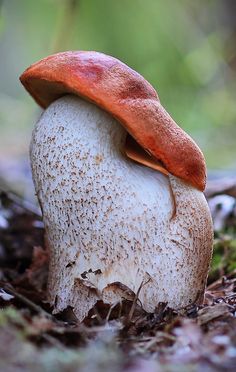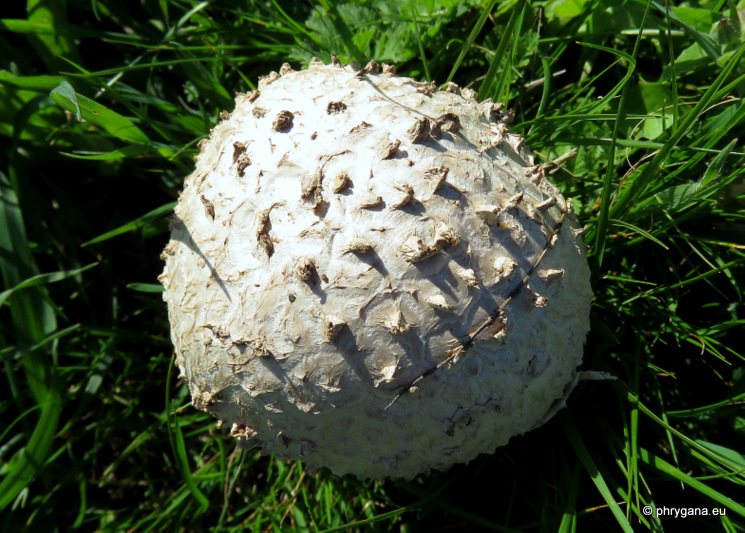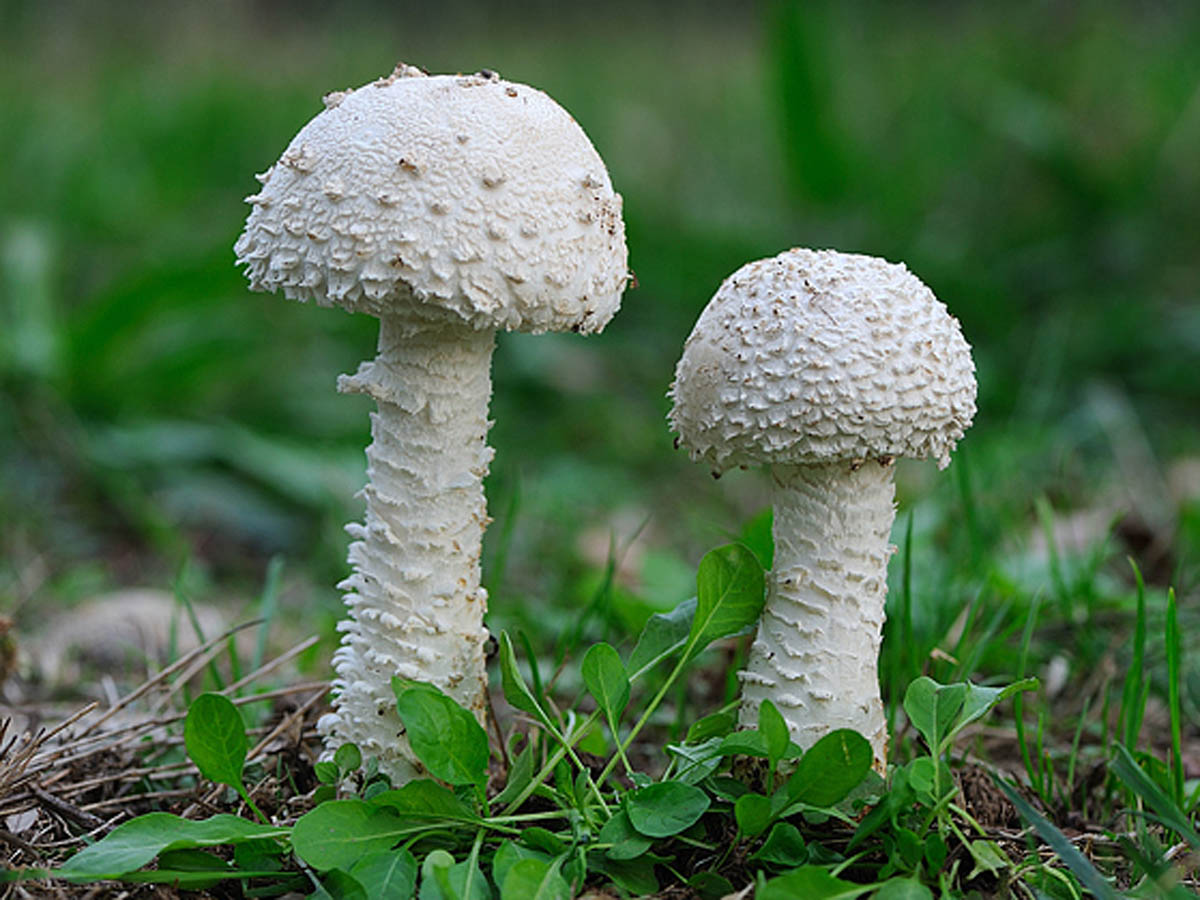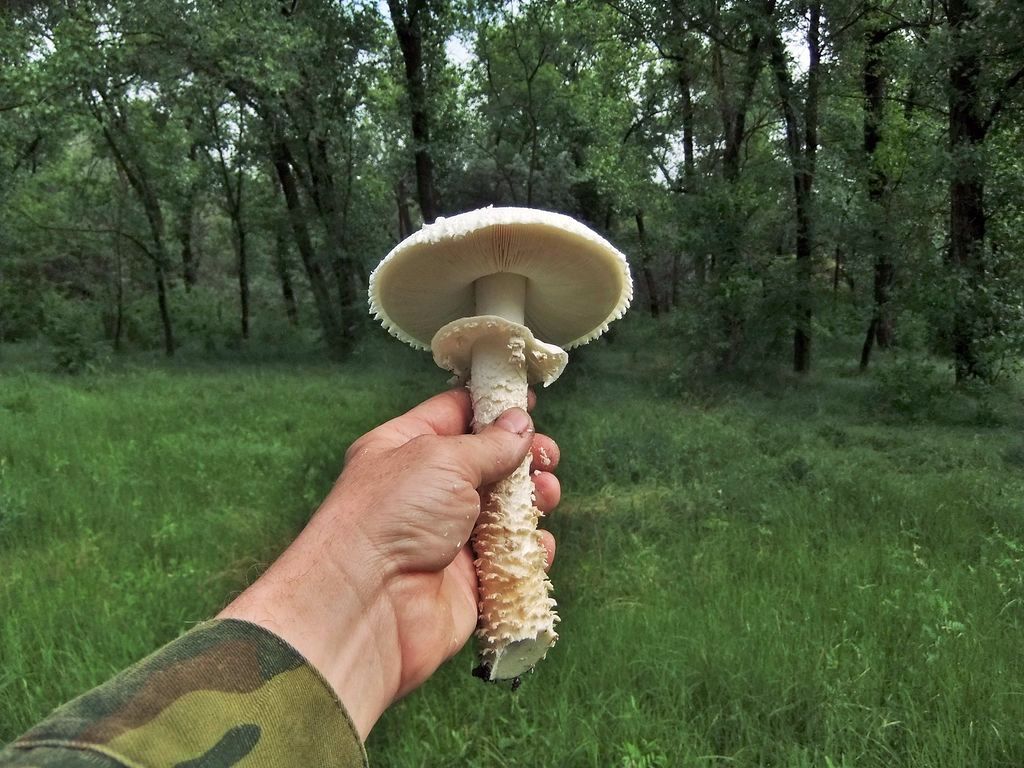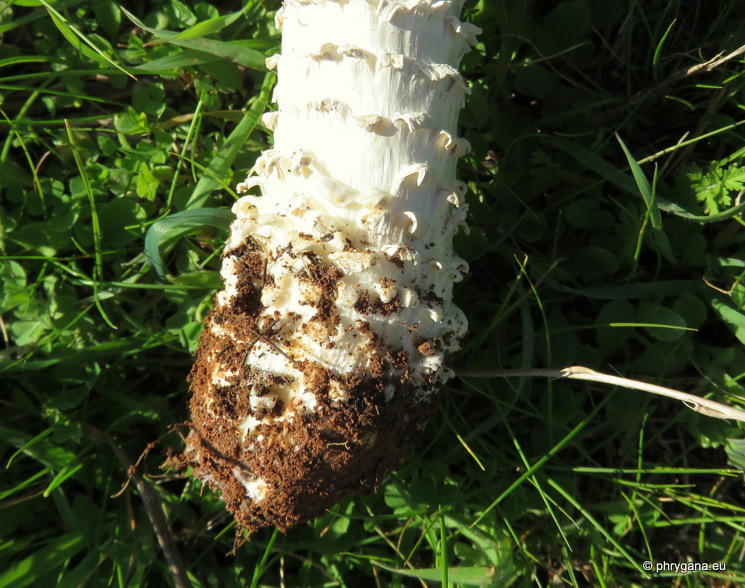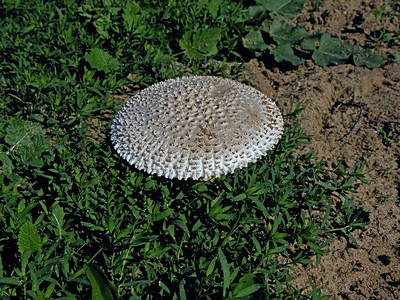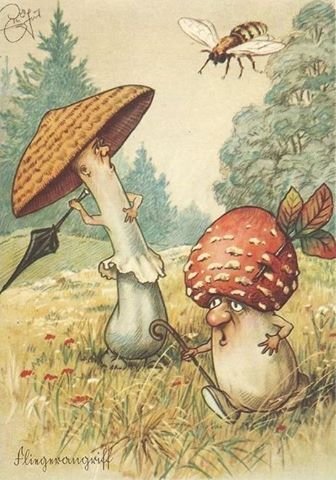Fly agaric Vittadini: photo and description
| Name: | Fly agaric Vittadini |
| Latin name: | Saproamanita vittadinii |
| Type of: | Conditionally edible |
| Synonyms: | Agaricus vittadinii, Amanita vittadinii, Armillaria vittadinii, Aspidella vittadinii, Lepidella vittadinii, Lepiota vittadinii. |
| Specifications: |
|
| Systematics: |
|
Fly agaric Vittadini is a conditionally edible representative of the Amanitov family, but some sources attribute it to the inedible category. So to eat this species or not is an individual decision. But, in order not to confuse it with poisonous specimens, you need to carefully read the external characteristics, view photos and videos.
Description of the fly agaric Vittadini
Fly agaric Vittadini can easily be confused with poisonous cousins, so you need to start getting to know him with external characteristics. It will also be important to view photos and videos.
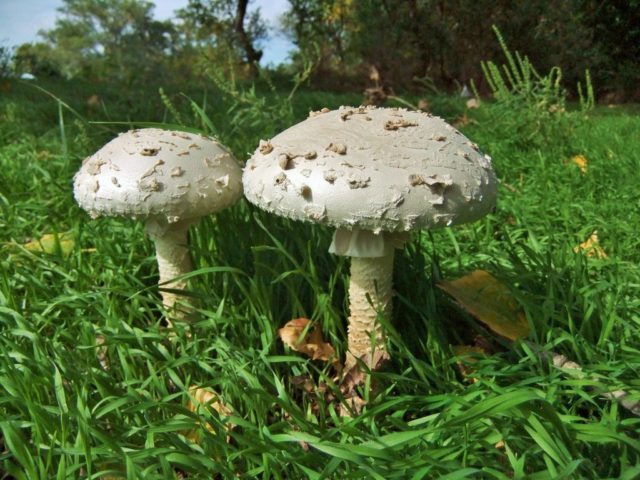
Suitable for fried, stewed and boiled dishes
Description of the hat
The fruit body has a large cap, up to 17 cm in diameter. The surface is covered with a whitish or light gray skin with numerous dark growths. There are also specimens with a greenish surface. A bell-shaped or prostrate cap has smooth, uneven, or ribbed edges. The lower layer is formed by loose, thin, whitish plates. At a young age, they are covered with a film, which, as the fungus grows, breaks and descends on the leg. Fruiting occurs in oblong spores, which are located in a snow-white powder.
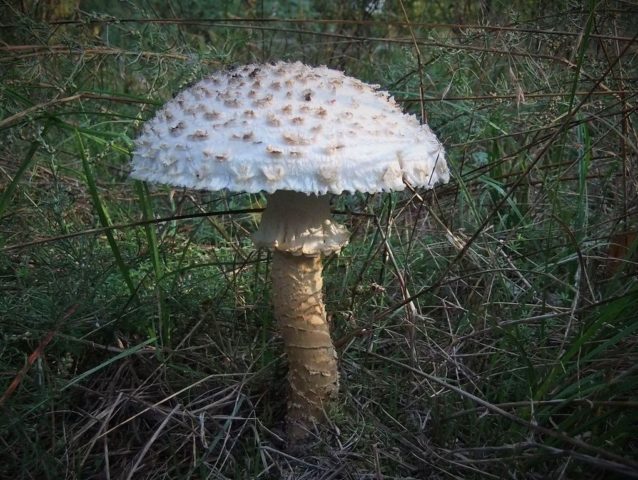
The hat is covered with numerous dark scales
Leg description
Smooth leg, 10-15 cm long, covered with a white skin. Towards the base, the shape narrows and takes on a coffee color. The species has a distinctive feature: the presence of rings on the leg, which consist of white pointed scales and a vulva located at the base. The vulva can be seen only in young representatives, as it grows, it becomes thinner and disappears over time.
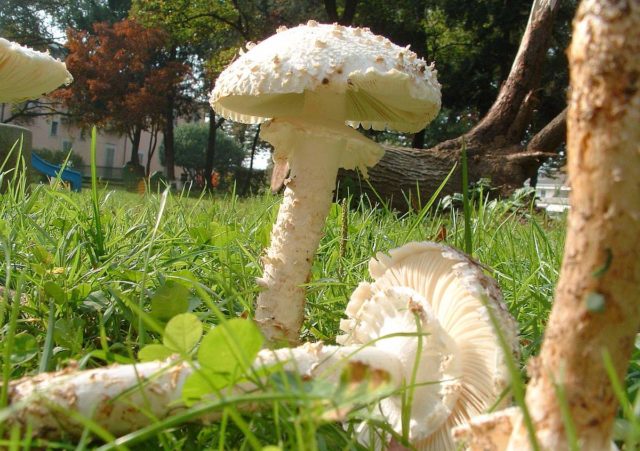
The leg is long, surrounded by a tight ring
Where and how it grows
Amanita Vittadini is widespread in the southern regions, in mixed forests, forest plantations, in virgin steppes. Grows in single specimens, less often in small families. Begins fruiting from May to October.
Edible mushroom Vittadini or poisonous fly agaric
Amanita Vittadini, because of its pleasant taste and aroma, is eaten fried, stewed and boiled. But since the species has very similar deadly poisonous counterparts, experienced mushroom pickers do not recommend collecting it.
Amanita Vittadini, like all edible representatives, bring benefits and harm to the body.
- enhances immunity;
- strengthens blood vessels and normalizes blood pressure;
- calms the nervous system;
- normalizes the metabolic process and removes bad cholesterol;
- satisfies the feeling of hunger, therefore mushroom dishes are recommended for people who monitor their weight;
- stops the growth of cancer cells.
Mushroom dishes are not recommended for children under 7 years old, pregnant women, people with intestinal and stomach diseases, and 2-3 hours before bedtime.
To have an idea of what the Vittadini fly agaric looks like, you need to view photos and videos, as well as know the external characteristics of inedible brethren.
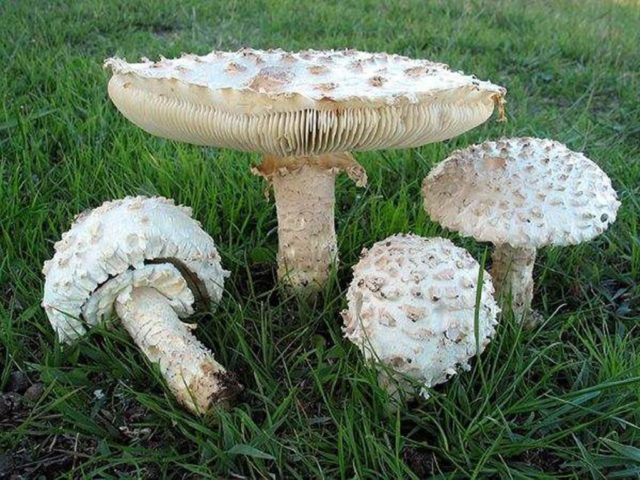
A rare species grows in single specimens or in small families
Doubles and their differences
Amanita Vittadini, like any forest dweller, has similar twins. These include:
- Amanita muscaria white or spring - a deadly poisonous representative of the forest kingdom. It can be recognized by a rounded or straightened snow-white hat with a small depression in the center.The surface is dry, velvety, reaches a diameter of no more than 10 cm. The hollow stem is cylindrical, colored to match the cap. The surface is fibrous, scaly. The snow-white pulp is dense, exudes a sharp unpleasant aroma. Leads to death if eaten.
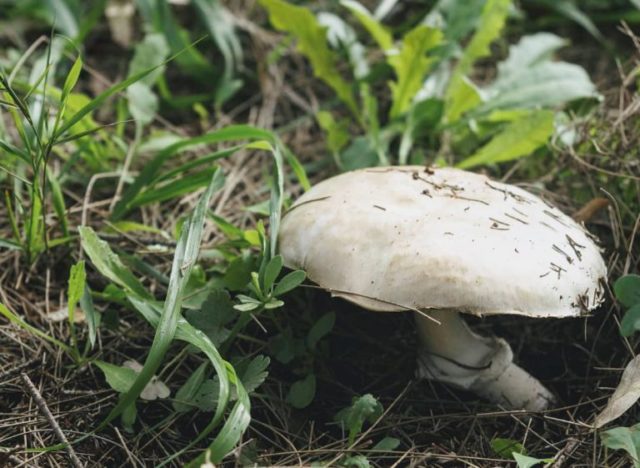
Deadly representative of the mushroom kingdom
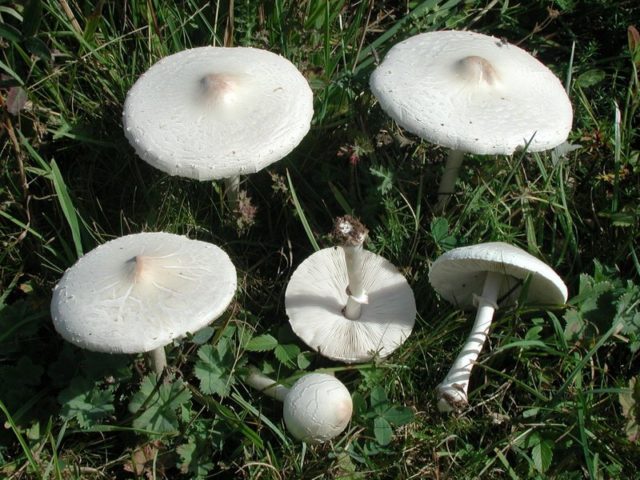
Nice view with pleasant taste and smell
Conclusion
Amanita Vittadini is an edible representative of the mushroom kingdom. During a drought, the fruit body stops growing and falls asleep; after rains, the fungus recovers and continues its development. Since this representative looks like a deadly poisonous fellow, you need to carefully read the external characteristics. But if during the mushroom hunt there is some doubt about the authenticity, then it is better to pass by.
Portrait 12. Terrible on the face - kind inside
Fly agaric Vittadini Amanita vittadinii
I got acquainted with these mushrooms about 10 years ago. Somehow, near the canal in the meadow, I found such bristling lads.
With all their appearance, the mushrooms seemed to hint that they are poisonous. Typical fly agaric species, and even ruffy. At home, rummaging through the identifiers, I realized that these are really fly agarics. And that there are several species of similar white fly agaric that prefer to grow in meadows. At first I took my find for the lone fly agaric Amanita solitaria, which is very similar to Vittadini. But then I came to the conclusion that it was Vittadini. And what is curious: both the lonely fly agaric and Vittadini are among the edibles!
I know that there are non-poisonous fly agarics, for example, the gray-pink fly agaric (rare in the Lower Don). Residents of the middle lane willingly collect and eat it (who knows). Or Caesar's delicious fly agaric in the mountains and foothills of the Caucasus. But you must admit that it is difficult to break yourself and make you try the fly agaric - the very embodiment of poisonousness! This rule has been hammered into me since childhood. In addition, the fresh smell of these fly agarics, frankly, is "not very". But curiosity got the better of it. The first trial turned out to be “fatal”. and since then I have become a great admirer of these mushrooms. I love champignons, but now if I find champignon and Vittadini (they grow in the same places), and if I have to choose, I will not hesitate to choose amanita. During heat treatment, the unpleasant odor disappears, and the cooked mushrooms are incredibly tasty.
As already mentioned, the Vittadini fly agarics are representatives of open spaces, saprotrophs, as well as the overwhelming number of champignons. But they grow both in groves and in rare forests, preferring clearings, sparse places and the outskirts of the forest.
The mushroom is thermophilic, a typical southerner. It is not found in the central zone, and even more so to the north. Very fleshy, with a dense leg. The hat can swing out from the palm.
The mushroom itself is white, at first it is all ruffled, but then visible warts remain only on the cap. And sometimes they disappear.
The leg becomes even harder with age, it can acquire a yellowish tint, which is why it is better not to take it from adult mushrooms. As befits fly agarics, there is a ring on the leg and a volva (a pouch at the base of the leg). But Vittadini's Volvo is flimsy, quickly disappears, it can be seen in the youngest mushrooms, and even then not always. In old mushrooms, the plates become beige, sometimes with a touch of ocher, and the unpleasant odor intensifies. It is also not advisable to take such mushrooms.
Young and old
The mushroom is listed in the Red Book. I never pick mushrooms from the Red Book. And before these fly agarics were really few. But every year there are more and more of them, and now it is one of the most massive mushrooms in our virgin steppes and meadows. In fruitful years, the Vittadini fly agarics are even ahead of champignons in quantity. Therefore, for them, I make an exception, I collect. But what pushed them to such a massive and rapid increase in the livestock, or rather, "poshlyapkovya", is not clear, but a gratifying fact.
They appear in the second half of May, grow during the entire warm period, and end in the second half of autumn. Probably, "thanks" to its appearance, the fly agaric Vittadini always stands untouched. In the worst case, he is knocked down and trampled.This is the psychology of some people: if a “toadstool”, then you have to knock it down, trample it!
Maybe after the publication of this article, the number of connoisseurs of these fly agarics will increase
But I would like to draw your attention to the fact that information about the edibility of Vittadini's amanita is contradictory. So what to eat or not to eat is up to you
I made my choice.
But if you still do not dare to eat Vittadini - do not knock when you meet him! Even if his appearance seems to you a bit filthy.
Amanita Vittadini - description, where it grows, the toxicity of the mushroom
Amanita mushroom Vittadini belongs to the Amanita family. There is still controversy over whether they can be eaten. Some sources say they are poisonous. Others argue that the mushroom is completely edible, and does not pose any danger to health. Most likely, in this case, it would be appropriate to consider representatives of this species conditionally edible mushrooms.

In Latin, its name sounds like Amanita vittadini.
Appearance
The cap of mushrooms of the type Amanita Vittadini is usually white. But sometimes there are specimens in which it is painted brown or greenish.
The diameter may vary. It ranges from 5 to 14 cm. There are remnants of a bedspread with scaly thorns on the cap. Their base is angular, they are noticeably convex. At the periphery, these residues are separated from the skin of the fungus.
The plates under the cap are also white. Spores have a smooth surface, amyloid. The shape of the disputes is irregular in the form of an ellipse. And the spore powder is also white.
The stem of these mushrooms is in the shape of a cylinder. It is also white, but narrows slightly towards the base and becomes darker. There is a smooth ring on the leg. Young mushrooms are enclosed in a common volva. In adult mushrooms, it disappears over time. Only traces remain of it, which are represented by scales located both on the cap and on the stem of the mushroom.
Where grows
They also grow in other European countries, which are characterized by a warm climate. You can meet them almost throughout the territory, from Italy to the British Isles. There are representatives of this species in Asian countries. They grow in the Far East. You can meet this fly agaric both in Israel and in the Caucasus. There is this mushroom also on other continents. Found in Africa as well as in America.
Favorite growing places of this species of mushrooms are steppes and forest-steppe, located near the forest belt. On the territory of southern Europe, this fly agaric can be found very rarely. Perhaps that is why the inhabitants are wary of him, and believe that he is poisonous. The fruiting period of the fly agaric Vittadini is quite long. You can collect them from mid-spring to mid-autumn. They grow on different types of soil.
Similarities with other species
Outwardly, representatives of this species are quite similar to the white fly agaric. And this mushroom is very poisonous. Its use can be fatal. This may be another reason many people avoid the Vittadini fly agaric. They are simply afraid to be confused.
Even in appearance, it is very similar to an umbrella, painted white. There is no danger to such a similarity.
Classification
Mycologists attribute this species to the genus Lepidella. But many of them believe that representatives of this species have both the traits of mushrooms belonging to the genus Amanita and the traits of Lepiot.
Peculiarities
It is noteworthy that these fungi, when the body dries out (in case they are not young), do not lose their vitality. Therefore, they may temporarily stop growing due to drought, but when the rains blow, the mushroom will come to life again and will continue to grow.
Related mushrooms
Another related species, which is also conditionally edible, is the Elias fly agaric. The cap is initially egg-shaped, and then becomes flatter with a tubercle in the middle. It can be painted white, beige, and sometimes pinkish. Brown specimens are also found. There are remnants of the bedspread on it. There is a ring on the leg.
The species grows in the Mediterranean. In Russia, you can find it extremely rarely. You can see it in the forest under walnut, beech, etc.
Amanita gray-pink (reddening), very tasty
Amanita rubescens looks unappetizing, although it is a very tasty edible mushroom. It is fried and pickled. I know people who consider the gray-pink fly agaric one of their favorite mushrooms. Such brave lucky ones have few competitors among mushroom pickers. They regret that many people knock down these common fly agarics with their feet or sticks, considering them a poisonous toadstool. Amanita muscaria is loved by flies and worms, so it is often wormy.
The hat (up to 10 cm in diameter, rarely up to 18 cm) is a gray-pink fly agaric at a young age, hemispherical. A mature mushroom has a hunchback-shaped cap of a dirty pink or grayish pink color. It has many dirty gray or brownish warty growths that resemble flakes. The plates are frequent, wide, white. With age, they become slightly pinkish.
The pulp is fleshy, thick, white or slightly pink in color. At the break, it slowly turns pink or becomes wine-colored. Hence the second name of the fly agaric - "red mushroom". The taste is slightly sweet. There is no particular smell.
The leg (up to 15 cm high) is light, it has a soft falling ring. Over time, the leg turns pink or dark wine color. The base is thickened, but not always tuberous.
Amanita muscaria grows more often in open grassy places. Its fruiting time: June - October.
This mushroom can be cooked only after preliminary boiling, and the first water must be drained
When collecting, it is important not to confuse the gray-pink fly agaric with the panther fly agaric.
Amanita gray-pink, photo from Wikipedia
There are other edible fly agarics, but they should be left for those mushroom pickers who know these mushrooms "by sight". Among them are the edible fly agaric (Amanita solitaria), which is similar to the deadly poisonous fly agaric (Amanita proxima) and the white stinking fly agaric (Amanita virosa). The edible fly agaric (Amanita spissa) is easily confused with the panther fly agaric (Amanita pantherina).
Amanita is bright yellow, poisonous
Amanita gemmata (Amanita gemmata) in most countries is considered deadly poisonous twisted. It grows from early summer to autumn.
The hat has a bright yellow, lemon or orange-yellow color. There are many white "flakes" on its surface, which are the remnants of the bedspread. At a young age, the plates of the cap are white, later they can turn brownish. The aroma of the pulp resembles that of a radish.
Leg. The leg is fragile, not always velvety, often elongated. Its ring can completely disappear as the mushroom matures. The base of the leg is extended
It is on him that you need to pay attention so as not to confuse a poisonous fly agaric with a russula
Fly agaric bright yellow, photo from Wikipedia
Appearance
The cap of mushrooms of the type Amanita Vittadini is usually white. But sometimes there are specimens in which it is painted brown or greenish.
The diameter may vary. It ranges from 5 to 14 cm. There are remnants of a bedspread with scaly thorns on the cap. Their base is angular, they are noticeably convex. At the periphery, these residues are separated from the skin of the fungus.
The plates under the cap are also white. Spores have a smooth surface, amyloid. The shape of the disputes is irregular in the form of an ellipse. And the spore powder is also white.
The stem of these mushrooms is in the shape of a cylinder. It is also white, but narrows slightly towards the base and becomes darker. There is a smooth ring on the leg. Young mushrooms are enclosed in a common volva. In adult mushrooms, it disappears over time. Only traces remain of it, which are represented by scales located both on the cap and on the stem of the mushroom.
Red Book
Are you here:
Home - the Red Book of the Rostov region. Plants - Amanita wittadini KK Rostov region
Fly agaric vittadini KK Rostov region
Department of Basidiomycetes - Basidiomycota Class Agaricomycetes - Agaricomycetes Order Agaricaceae - Agaricales Amanita family - Amanitaceae Amanita vittadinii (Moretti) Vittad. Rarity status category. 3 g (3).A rare species with a significant range, but located in the Rostov region. at the border of distribution. RKR - V. In Russia - a rare species.
Description
Cap (4) 7–17 (20) cm in diameter., Thick-fleshed, at first semicircular, broadly bell-shaped, later prostrate, with a blunt tubercle, off-white, sometimes slightly greenish or brownish, covered with large warts, turning into scales along the edge. The plates are wide, free, frequent, at first white, later with a grayish-cream shade. The stem is white, cylindrical, narrowed towards the base, 8–16 × 1.5–2.5 cm, with a strong, wide, double, warty, whitish ring, below which it is covered with concentrically located white scales, with rapidly disappearing, noticeable only on young fruiting bodies with volvoy. The pulp is white, slightly yellow during autooxidation, with a faint pleasant odor. The spore powder is whitish.
Spreading
View with a wide range covering Europe, Asia, North. Africa, North. and Yuzh. America; in Russia, it is distributed in the Astrakhan, Belgorod, Rostov and Saratov regions, Primorsky and Stavropol regions, the Republic of Kalmykia. - In the Rostov region. found in Rostov-on-Don, Myasnikovsky (farm. Nedvigovka) and Orlovsky (farm. Kamyshevka) districts.
Features of biology and ecology
Humus saprotroph, possibly, in some cases, is an optional mycorrhizal forming agent. It grows in dry sod grass and wormwood-sod grass steppes, forest plantations, forest belts. Fruiting V – X.
Number
In Rostov-on-Don, the fruiting of the species was recorded in 1991 in the village. Chkalov and the Botanical Garden of the Southern Federal University and after that it was not celebrated. Population in deciduous forest stands in the vicinity of the hut. Nedvigovka bears fruit quite steadily, fruiting bodies are found singly or in small groups, however, there is a possibility of its destruction due to anthropogenic load. Population near the hut. The warbler in the area of the highly depleted dry herb-sod grass steppe is in fairly stable conditions.
Limiting factors
Anthropogenic disturbances of the habitat (compaction of the surface layer of the soil and destruction of the litter), destruction of fruit bodies by the population.
Security measures
Included in the CC of Russia (2008). Protected on the territory of the protected zone GPBZ "Rostovsky", on the protected area "Botanical Garden of the Southern Federal University" in Rostov-on-Don. It is necessary to study the dynamics of populations, search for new locations. As an additional measure of protection, it is desirable to obtain pure crops from different populations of the species.
Practical value. Not known.
Sources of information. 1. Wasser, 1992; 2. Bedenko, 1980; 3. Vasilieva, 1973; 4. Lebedeva, 1949; 5. Herbarium collections (LE); 6. Compilers data; 7. Vychepan, Rusanov, 1996; 8. Rusanov, Vychepan, 2004.
Compilers. Rebriev Yu.A., Rusanov V.A.
Photo. Yu.A. Rebriev
|
15.12.2017 20:40:23
-
Menu
- home
- Photo gallery
-
Animals
- Mammals
- Birds
- Fishes
- Amphibians
- Reptiles
- Insects
- Crustaceans
- Worms
- Molluscs
-
Plants
- Angiosperms
- Gymnosperms
- Ferns
- Mosses
- Seaweed
- Lichens
- Mushrooms
- Moscow
-
Moscow region
- Mammals
- Birds
- Invertebrates
- Pisces, presm., Terrestrial.
- Plants
- Mushrooms, mosses, lichens
-
Voronezh region
- Plants
- Animals
-
Republic of Crimea
- Plants
- Animals
-
Rostov region
- Plants
- Animals
-
Krasnodar Territory
- Plants
- Animals
-
Leningrad region
- Plants
- Animals
-
Pskov region
- Plants
- Animals
-
Sverdlovsk region
- Plants
- Animals
-
Saratov region
- Mushrooms
- Bryophytes
- Ferns
- Amur region
- Krasnoyarsk Territory
- Belgorod region
-
Chelyabinsk region
- Plants
- Animals
-
IUCN Red List
- Extinct mammals
- Rare birds of the world
- Cetaceans
- Carnivores
- Reserves of Russia
- Wild animals
- Birds of Russia
- Download the Red Book
- Basic documents
- Custom sog.
- .
Fly agaric (Amanita franchetii)
Amanita franchetii is a mushroom belonging to the Amanitov family, genus Amanita.
External description of the mushroom
Rough fly agaric (Amanita franchetii) is a fruiting body with a semi-circular, and later - a spread cap and a whitish leg with yellowish flakes on its surface.
The diameter of the cap of this flu is from 4 to 9 cm. It is quite fleshy, has a smooth edge, is covered with a yellowish or olive skin, and itself has a brownish-gray color. The mushroom pulp itself is white, but when damaged and cut it becomes yellowish, exudes a pleasant aroma, and has a good taste.
The leg of the mushroom has a slightly thickened bottom, tapers upward, initially dense, but gradually becomes hollow. The height of the mushroom leg is from 4 to 8 cm, and the diameter is from 1 to 2 cm. The hymenophore part, located on the inner side of the mushroom cap, is represented by the lamellar type. The plates can be located in relation to the leg freely, or slightly adhere to it with a tooth. They are often located, characterized by expansion in their middle part, white. With age, their color changes to yellowish. These plates contain white spore powder.
The remains of the bedspread are represented by a weakly expressed Volvo, which is distinguished by its looseness and dense accretion. They are grayish-yellow in color. The mushroom ring is characterized by an uneven edge, the presence of yellow flakes on its whitish surface.
Habitat and fruiting period
Amanita franchetii grows in mixed and deciduous forests, prefers to settle under oaks, hornbeams and beeches. Fruit bodies are found in groups and grow on the soil.
The fungus of the described species is widespread in Europe, in the Caucasus, Central Asia, Vietnam, Kazakhstan, Japan, North Africa and North America. Amanita muscaria fruiting occurs most actively during the period from July to October.
Edibility
There is no reliable information about the edibility of the mushroom. In many literary sources, it is designated as an inedible and poisonous mushroom, so it is not recommended to eat it.
Similar species, distinctive features from them
The rare distribution of the rough fly agaric and the specific signs of the fruiting body make this type of mushroom unlike other varieties of mushrooms from the genus Amanita.
Interesting information about the rough fly agaric
At this point in time, it is not reliably known whether the rough fly agaric is an inedible or, conversely, an edible mushroom. Some of the authors of books on mycology and mushroom science note that this type of mushroom is inedible, or nothing is known for certain about its edibility. Other scientists say that the fruiting bodies of the rough fly agaric are not only completely edible, but also have a pleasant aroma and taste.
In 1986, the scientist-researcher D. Jenkins discovered the fact that in the Persona herbarium the scabies are represented by the type Lepiota aspera. In addition, E. Fries created a description of the mushroom in 1821, in which there was no indication of the yellowish tint of the Volvo. All these data made it possible to classify the fungus Amanita aspera as a homotypic synonym for the fungus Lepiota aspera, and as a heterotypic synonym for the fungus of the species Amanita franchetii.
Pluggable locator:
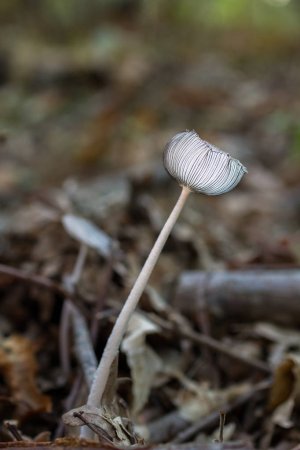 Quick and easy
Quick and easy
 Lolly, lolly
Lolly, lolly
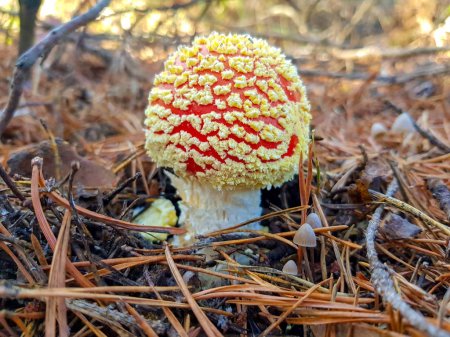 Amanita muscaria
Amanita muscaria
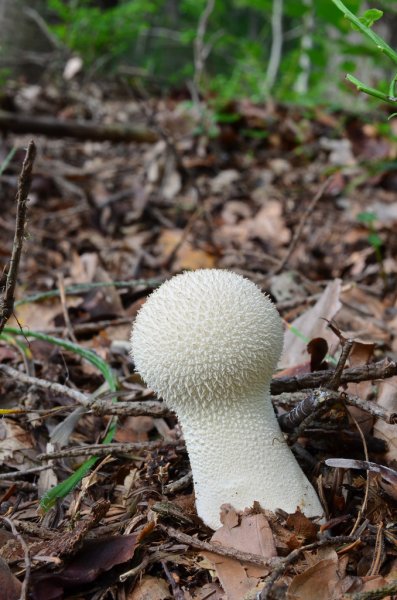 Line
Line
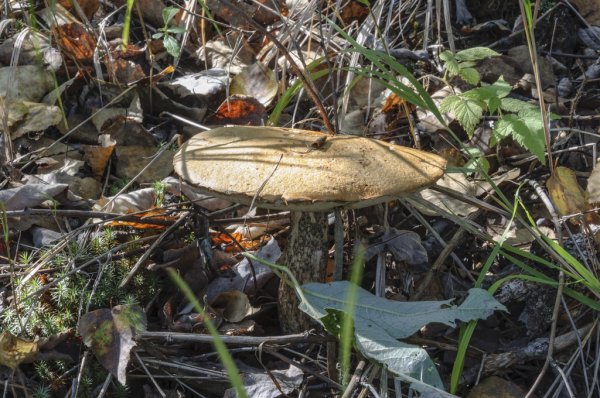 Shopping cart. РоÑÑиÑ
Shopping cart. РоÑÑиÑ
.
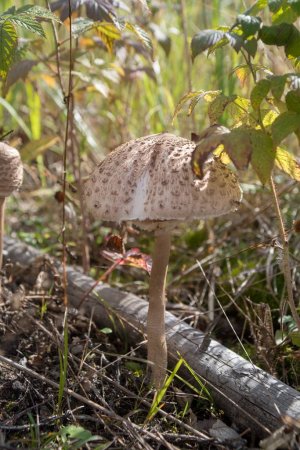 Burgundy and burgundy burgundy
Burgundy and burgundy burgundy
 Bumpy line
Bumpy line
.
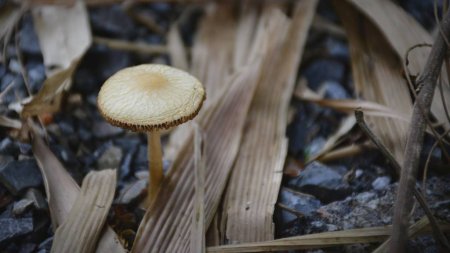 Burgundy
Burgundy
 Burgundy
Burgundy

